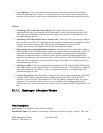• Busy - The server is busy performing its function. Most servers do not update Usage State
dynamically, so it is unlikely you will see this value reported.
• Unknown - The server has not reported a recognized Usage State.
Administrative State. The Administrative State of the server. The possible states are:
• Shut Down - The server shut itself down in an orderly way.
• Force Halt - The server accepted a Force Halt command and terminated immediately.
• Reinitialize - The server reinitialized itself. Not all HPSS servers support being reinitialized.
• Mark Repaired - The server cleared its error states.
• Unlocked - Displayed during normal server operation.
Execution State. The Execution State of the server. Possible values are: Active, Initializing, Restarting,
Terminating, Inactive, Suspending, Suspended, and Resuming.
Service Status. The server’s service status. Possible values are: Normal, Warning, Minor Problem,
Major Problem, and Critical.
Security Status. The server’s security status. Possible values are: Normal, Warning, Minor Problem,
Major Problem, and Critical.
Software Status. The server’s software status. Possible values are: Normal, Warning, Minor Problem,
Major Problem, and Critical.
Hardware Status. The server’s hardware status. Possible values are: Normal, Warning, Minor Problem,
Major Problem, and Critical.
Communication Status. The server’s communication status. Possible values are: Normal, Warning,
Minor Problem, Major Problem, and Critical.
Using the Basic Server Information Window
Most HPSS servers allow the SSM user to view the server’s states and statuses.
Under normal conditions, the server states and statuses reported on the Server Information window are as
follows:
Operational State: Enabled
Usage State: Active
Administrative State: Unlocked
Execution State: Active
Service Status: Normal
Security Status: Normal
Software Status: Normal
Hardware Status: Normal
HPSS Management Guide November 2009
Release 7.3 (Revision 1.0) 126


















